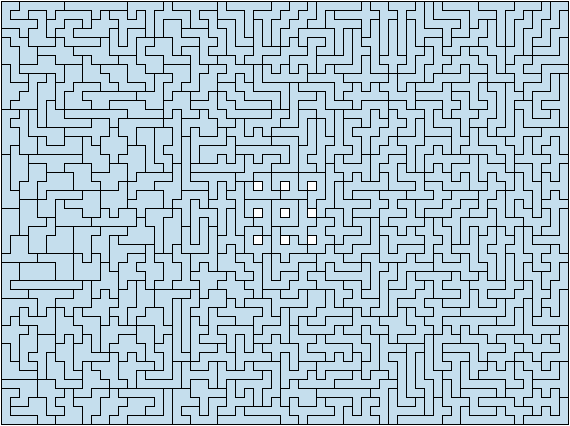It's been ages since I last wrote anything on here (so much for that promise I'd update this with a little more frequency) so have some first-draft-quality rambling about polyform-ish puzzles that are sort of just close enough to fit the theme of the blog.
3x3x3 Serially Interlocking Cube
I built this one after seeing a diagram of the pieces in Stewart T. Coffin's The Puzzling World of Polyhedral Dissections and not being able to visualise how on earth they fit together. It's a four-piece puzzle with the unusual property that it must be assembled and disassembled in a certain order (hence 'serially interlocking'); the pieces all kind of hold each other in place. It's not too hard a solve; the very first assembly takes a little bit of thinking but any assemblies and disassemblies after that aren't hard at all because you end up just sort of memorising what goes where, which spoils the fun a bit.
 |
| The two visible red bits are two parts of the same piece. Likewise with the blue bits. It's a weird puzzle. |
Building this was something of a trial run for other polycube puzzles. I wanted a full set of pentacubes for the longest time (and still do), and I decided the cheapest way to make polycubes was probably to buy the cubes and attach 'em together myself. So I went out (okay, stayed in and fired up the internet) and ordered in enough wooden cubes to make Mio Naganohara seethe with envy, then set about making the tetracubes you can see half way down this page as well as these pieces. The problem is, the combination of my own shoddy handiwork and the cubes not being exactly cubic meant that the resulting pieces didn't quite fit together as snugly as I'd hoped. Not so bad with the relatively simple tetracube shapes, but with these pieces there's C-pentomino-esque indentations that need to be able to fit round another cube and those require a degree of exactness. So I spent a good couple of hours sanding down the glued-up pieces just to make them actually fit together and then come apart afterwards without getting stuck.
And then I scribbled on them with felt tips because I couldn't be arsed to look for paint. It's eye-catching from a distance, but when you actually hold the pieces and examine them up close it's like something a child would make in their first woodworking lesson. But it's the best I can do without resorting to things like putting effort in...
 |
| Fig. 2: The pieces in all their terrifying glory. Between this photo and the one above there's probably enough info for readers to make their own set if desired. |
Polyarcs
Another one I made myself. It's made of the same materials as my heptiamonds and their tray, which makes me think I just chucked the SVGs for these in the margins then sent the lot to the laser cutting place to get more puzzle for my money.
Polyarcs are the polyforms where the base units are the two shapes you get drawing a quarter circle inside a unit square. There's a bunch of information and constructions involving the 1- through 3-arcs over on Henri Picciotto's site.
 |
| Fig. 3: These bad boys were spared the humiliation of a felt tip paint job. |
This is the set of two 1-arcs and seven 2-arcs, and they fit in that 2x4 tray in dozens of ways; it's not particularly hard to get them back in there after tipping them out. Putting them in so that the wood grain lines up works as a marginally harder challenge. I kind of hoped I'd be able to make some other shapes with these too, but they're kind of limiting in that there's such a small total area to work with. They do the rounded shape from that linked site in a few ways too.
Sadly, I don't think they can make the 4-way rotationally symmetrical shape on the right - I can get all but one piece in so I'm wondering if there's some parity-like constraint preventing this from working, or if it's just a case of 'the pieces won't go'.
Unnamed 8x8 polyomino puzzle
This one's a doozy. At least it is if you take your dictionary, scribble out the definition for the word 'doozy' and write 'pain in the ass' there instead.
It solves into an 8x8 tray, not unlike the pentominoes + O-tetromino set I probably thought this was when I first bought it (for the grand sum of £2). But the pieces are bizarre. Four of the most uncooperative pentominoes (U, X, T and W), the T- and U-hexominoes (!) and a handful of larger 'ominoes seemingly picked at random. And the worst of it is, it's a really infuriatingly tricky puzzle. There's not a time I've picked this up and not put it down feeling like uppercutting a nun. Even when I manage to solve the thing, the rag-tag assortment of pieces is so illogical and un-mathematical it winds me up anyway.
Going through my cupboard of polyomino stuff and failed laser-cutting experiments, there's probably enough stuff there to write a second one of these posts some time, so consider this a Part 1.































